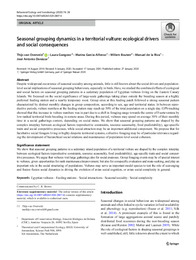Por favor, use este identificador para citar o enlazar este ítem:
https://hdl.handle.net/11000/7172Registro completo de metadatos
| Campo DC | Valor | Lengua/Idioma |
|---|---|---|
| dc.contributor.author | Overveld, Thijs van | - |
| dc.contributor.author | Gangoso, Laura | - |
| dc.contributor.author | García Alfonso, Marina | - |
| dc.contributor.author | Bouten, Willem | - |
| dc.contributor.author | de la Riva, Manuel | - |
| dc.contributor.author | Donázar, José Antonio | - |
| dc.contributor.other | Departamentos de la UMH::Biología Aplicada | es |
| dc.date.accessioned | 2021-02-25T09:50:57Z | - |
| dc.date.available | 2021-02-25T09:50:57Z | - |
| dc.date.created | 2020-01-27 | - |
| dc.date.issued | 2021-02-25 | - |
| dc.identifier.issn | 0340-5443 | - |
| dc.identifier.issn | 1432-0762 | - |
| dc.identifier.uri | http://hdl.handle.net/11000/7172 | - |
| dc.description.abstract | Despite widespread occurrence of seasonal sociality among animals, little is still known about the social drivers and populationlevel social implications of seasonal grouping behaviours, especially in birds. Here, we studied the combined effects of ecological and social factors on seasonal grouping patterns in a sedentary population of Egyptian vultures living on the Eastern Canary Islands. We focussed on the social significance of large-scale gatherings taking place outside the breeding season at a highly preferred feeding station and a nearby temporary roost. Group sizes at this feeding patch followed a strong seasonal pattern characterized by distinct monthly changes in group composition, according to sex, age and territorial status. In between reproductive periods, vulture numbers at the feeding station may reach up 50% of the total population on a single day. GPS-tracking showed that this increase in vulture numbers was in part due to a shift in foraging range towards the centre of Fuerteventura by low-ranked territorial birds breeding in remote areas. During this period, vultures may spend on average 30% of their monthly time in a social gatherings context, depending on social status. We show that seasonal grouping patterns are shaped by the complex interplay between ecological factors (reproductive constraints, resource seasonality, food predictability), age-specific traits and social competitive processes, while social attraction may be an important additional component. We propose that for facultative social foragers living in highly despotic territorial systems, collective foraging may be of particular relevance regarding the development of hierarchical social relations and maintenance of population-level social cohesion | es |
| dc.description.sponsorship | TvO received funding from the European Union’s Horizon 2020 research and innovation programme under the Marie Sklodowska-Curie grant agreement no. “SocForVul 659008 | - |
| dc.description.sponsorship | During writing, LG was supported by a Marie Sklodowska-Curie Fellowship of the European Commission (grant number: 747729 “EcoEvoClim”) | - |
| dc.description.sponsorship | MG-A was supported by a contract from “Programa de FPU del Ministerio de Educación, Cultura y Deporte” (FPU13/05429) | - |
| dc.description.sponsorship | The long-term monitoring of the vulture population has been funded by the projects REN 2000–1556 GLO, CGL2004-00270/BOS, CGL2009-12753-C02-02, CGL2012-40013-C02-01 and CGL2015-66966-C2-1-2-R (Spanish Ministry of Economy and Competitiveness and EU/FEDER) | - |
| dc.description.sponsorship | Further support was provided by the Cabildo Insular de Fuerteventura and the Dirección General de Protección de la Naturaleza (Viceconsejería de Medio Ambiente, Canarian Government). | - |
| dc.format | application/pdf | es |
| dc.format.extent | 13 | es |
| dc.language.iso | eng | es |
| dc.rights | info:eu-repo/semantics/openAccess | es |
| dc.subject | Egyptian vultures | es |
| dc.subject | Feeding stations | es |
| dc.subject | Social interactions | es |
| dc.subject | Seasonal sociality | es |
| dc.subject | Social complexity | es |
| dc.subject.other | 57 - Biología | es |
| dc.title | Seasonal grouping dynamics in a territorial vulture: ecological drivers and social consequences | es |
| dc.type | info:eu-repo/semantics/article | es |
| dc.identifier.doi | 10.1007/s00265-020-2807-4 | - |
| dc.relation.publisherversion | https://doi.org/10.1007/s00265-020-2807-4 | - |

Ver/Abrir:
14-van Overveld et al. 2020 Behavioral Ecology Sociobiology.pdf
1,33 MB
Adobe PDF
Compartir:
 La licencia se describe como: Atribución-NonComercial-NoDerivada 4.0 Internacional.
La licencia se describe como: Atribución-NonComercial-NoDerivada 4.0 Internacional.
.png)